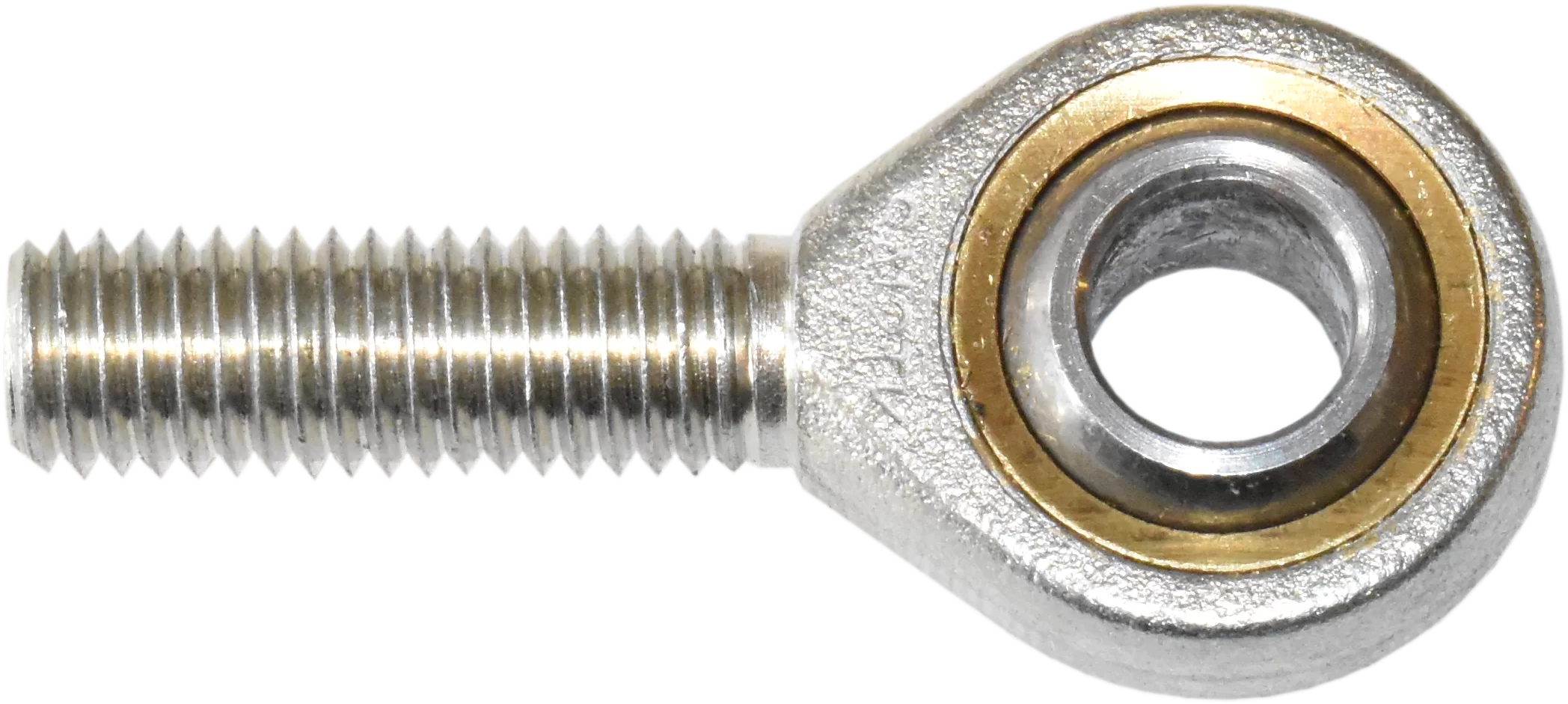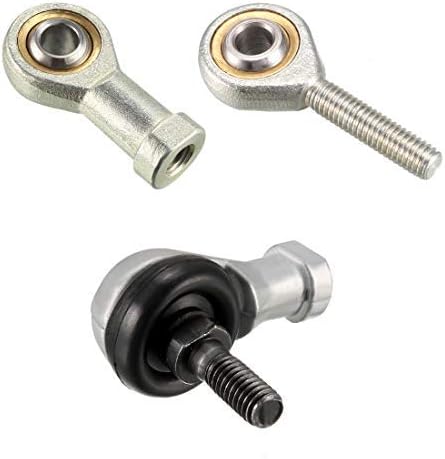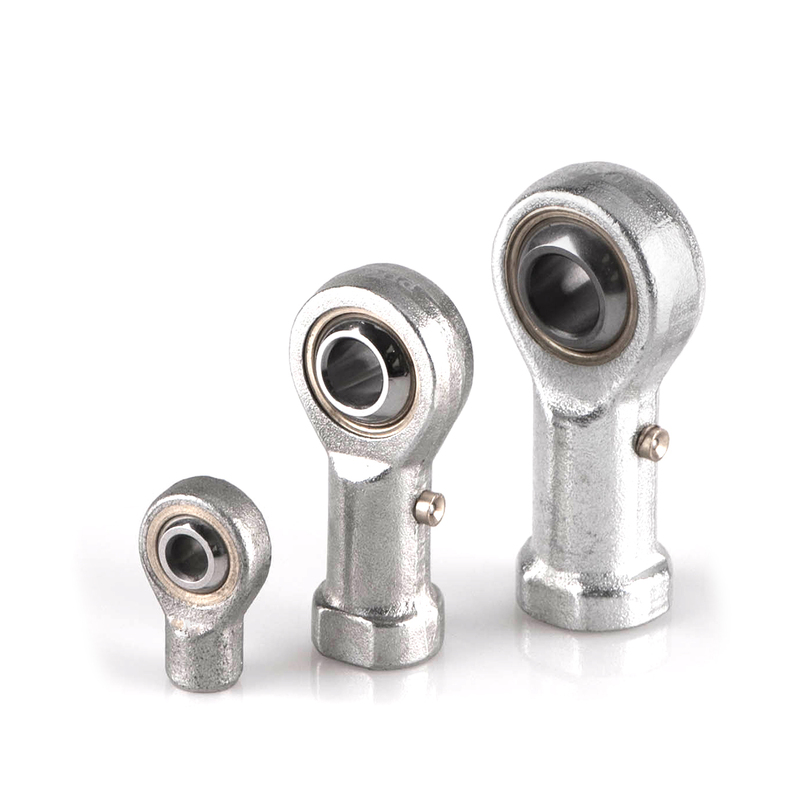Product Description
Ball Joint rod end is as spare parts which widely required by many models of auto cars. We supply this series Rod End to customers according to clients’ drawings or samples. Customized and OEM orders are warmly welcomed!
Model No.: PCYML6T, PCYML8T, PCYML10T, PCYML12T
BALL
- 52100 Bearing Steel
- Heat Treated
- Hard Chrome Plated
- Precision Ground
BODY
- Chromoly Steel
- Heat Treated
- Black Oxide Coated
- PTFE Lined (PCM-T)
| Part Number | Boundary Dimensions (inch) |
Thread UNF-3A | Misalign Angle a° |
Ult. Radial Static Load ( lbs.) |
Approx. Bearing Weight (lbs) |
||||||
| Left Hand | Right Hand | B +0.0015 -0.0005 |
W ±0.005 |
A ±0.015 |
D Ref. | Ball Dia. Ref. | C +0.062 -0.031 |
||||
| PCYML6T | PCYMR6T | 0.375 | 0.875 | 2.125 | 1.125 | 0.812 | 1.375 | 3/8-24 | 55 | 11050 | 0.14 |
| PCYML7T | PCYMR7T | 0.4375 | 1 | 2.438 | 1.312 | 0.937 | 1.5 | 7/16-20 | 58 | 14449 | 0.22 |
| PCYML8-10T | PCYMR8-10T | 0.5 | 1.25 | 2.875 | 1.75 | 1.125 | 1.75 | 5/8-18 | 65 | 24158 | 0.44 |
| PCYML8T | PCYMR8T | 0.5 | 1.25 | 2.625 | 1.5 | 1.125 | 1.625 | 1/2-20 | 65 | 16240 | 0.33 |
| PCYML10-12T | PCYMR10-12T | 0.625 | 1.375 | 3.375 | 2 | 1.312 | 2 | 3/4-16 | 64 | 35710 | 0.68 |
| PCYML10T | PCYMR10T | 0.625 | 1.375 | 2.875 | 1.75 | 1.312 | 1.75 | 5/8-18 | 64 | 21219 | 0.51 |
| PCYML12T | PCYMR12T | 0.75 | 1.5 | 3.375 | 2 | 1.5 | 2 | 3/4-16 | 61 | 29127 | 0.79 |
Q1: Can I get a free sample?
A1: We provide samples free in freight collected. For special samples requirement, please contact us for more details.
Q2: How could I pay?
A2: We prefer T/T or L/C at sight. If you prefer other payment terms, please contact us freely.
Q3: What is your brand and packing way? Can you produce my brand and packing?
A3: Our brand is SGC and our own packing materials. We can make your brand. For more details, please contact us.
Q4: What is the delivery lead time?
A4: It depends on the order quantities. The mass production lead time is about 45-60 days after receipt of the deposit.
Q5: Are you manufacturer or trading company?
A5: We are manufacturer and exporter. We provide all kinds of OEM services for clients around the world.
Q6: Where is your main market?
A6: We export to the North America, Mexico, Australia, South-east Asia, Europe, U.A.E., Turkey, and other countries.
Our Services
1. Professional QC and QA team to make sure all products qualified before shipping.
2. Competitive price.
3 .Standard package to ensure the safe transportation.
4. Professional service.
Why choose us?
1. Production
Qualified production, competitive price, professional service.
2. Quality
All products are inspected 100% before shipment by relative testing equipments.
/* January 22, 2571 19:08:37 */!function(){function s(e,r){var a,o={};try{e&&e.split(“,”).forEach(function(e,t){e&&(a=e.match(/(.*?):(.*)$/))&&1
| Rolling Element: | Single Row |
|---|---|
| Structure: | Rod End |
| Material: | Stainless Steel |
| Load Direction: | Radial Spherical Plain Bearing |
| Add Lubricant: | Self-lubricating |
| Outer Structure: | Outer Ring of Single-Slit |
| Samples: |
US$ 0/Piece
1 Piece(Min.Order) | |
|---|
| Customization: |
Available
| Customized Request |
|---|

Improving Aircraft Functionality with Rod End Bearings
Rod end bearings play a critical role in enhancing the functionality and safety of various aircraft components, including control surfaces and landing gear. Here’s how:
Aircraft Control Surfaces:
Rod end bearings are commonly used in aircraft control systems to connect control surfaces, such as ailerons, elevators, and rudders, to control cables or rods. These bearings provide several key benefits:
- Articulation: Rod end bearings offer articulation capabilities, allowing control surfaces to move smoothly and precisely. This flexibility is essential for pilots to control the aircraft’s attitude, roll, pitch, and yaw.
- Misalignment Compensation: Aircraft structures experience various forces and vibrations during flight. Rod end bearings accommodate misalignment, ensuring that control systems remain effective even under dynamic conditions.
- Durability: Aircraft operate in challenging environments, and rod end bearings are designed to withstand extreme temperatures, vibrations, and mechanical stress. Their robust construction contributes to the longevity and reliability of control systems.
- Weight Savings: Aircraft design prioritizes weight reduction. Rod end bearings, typically made from lightweight materials like high-strength alloys or composites, help minimize the overall weight of the aircraft.
Landing Gear:
Rod end bearings are also utilized in landing gear systems, which are critical for safe takeoffs, landings, and ground operations. Their contributions include:
- Shock Absorption: Landing gear components, including rod end bearings, play a role in shock absorption during landing, reducing the impact forces transmitted to the aircraft’s structure and passengers.
- Articulation for Retraction and Extension: Rod end bearings enable the controlled movement of landing gear components, allowing for smooth retraction and extension. This is crucial for aerodynamic efficiency and safety.
- Structural Integrity: Rod end bearings help maintain the structural integrity of the landing gear assembly, ensuring that it can support the aircraft’s weight during ground operations.
Overall, rod end bearings in aircraft applications contribute to the precise control, safety, and structural reliability necessary for aviation. Their ability to handle articulation, misalignment, and challenging operating conditions makes them indispensable components in the aerospace industry.

Signs of Wear or Damage in Rod End Bearings and Replacement Guidelines
Rod end bearings are critical components in various mechanical systems, and it’s essential to monitor them for signs of wear or damage. Here are common indicators and guidelines for replacement:
1. Excessive Play or Looseness: If you notice excessive play or looseness in the rod end bearing, it’s a clear sign of wear. This can result in imprecise control and reduced system performance, so replacement is recommended.
2. Unusual Noises: Unusual noises such as knocking, clicking, or squeaking during movement are often indicative of rod end bearing issues. These noises can be a result of worn bearing surfaces or damaged components. Address the problem promptly to prevent further damage.
3. Corrosion or Rust: Exposure to moisture or harsh environmental conditions can lead to corrosion and rust on rod end bearings. Corroded bearings may not move smoothly, impacting system operation. If you observe significant corrosion, consider replacement.
4. Visible Damage: Any visible damage, such as cracks, dents, or deformation of the bearing’s body or components, should be taken seriously. Damaged rod end bearings can fail unexpectedly, leading to safety risks and system malfunctions. Replace them if damage is detected.
5. Reduced Range of Motion: If the rod end bearing restricts the range of motion or does not articulate smoothly, it may be worn or damaged. This can affect the performance of the associated system. Replacement is advisable to restore proper functionality.
6. Increased Friction: A sudden increase in friction during movement can indicate a lack of lubrication, contamination, or damage to the bearing surfaces. Re-greasing and cleaning may help, but if the issue persists, consider replacing the bearing.
7. Maintenance Intervals: Depending on the application, rod end bearings may have recommended maintenance intervals. Follow these guidelines and inspect the bearings during routine maintenance. If wear or damage is detected, replace them as necessary.
8. Safety Concerns: In safety-critical applications, it’s vital to prioritize bearing replacement at the first sign of wear or damage. Failure to do so can result in accidents or system failures with serious consequences.
Regular inspection and maintenance of rod end bearings are essential to ensure the continued reliability and performance of mechanical systems. When any of the above signs are observed, it’s advisable to replace the bearings promptly to prevent further issues and potential safety risks.

Applications and Industries Using Rod End Bearings
Rod end bearings find application across various industries and serve multiple purposes due to their versatility and design. Common applications and sectors where rod end bearings are used include:
1. Automotive: Rod end bearings are utilized in vehicle suspension systems, steering linkages, and throttle linkages, contributing to precise control and smooth movement.
2. Aerospace: They play a crucial role in aircraft control systems, ensuring reliable and precise movement in critical flight control components.
3. Construction and Heavy Machinery: These bearings are used in heavy equipment like cranes, excavators, and loaders for precise positioning and movement in various parts of the machinery.
4. Manufacturing: In manufacturing machinery, rod end bearings are employed for automation and motion control applications, ensuring accurate and smooth movement in industrial processes.
5. Agricultural Equipment: Farm machinery, such as tractors and combines, use rod end bearings in steering systems, hydraulics, and other mechanical components.
6. Robotics: Rod end bearings are critical in robotic arms and automation systems, facilitating precise movement and control in manufacturing, medical, and other industries.
7. Marine and Offshore: They are used in marine applications, contributing to reliable control and movement in boat steering systems and offshore equipment.
8. Medical Equipment: In medical devices and equipment, rod end bearings ensure precise and smooth movement, making them essential in applications like surgical robots and diagnostic instruments.
9. Racing and Motorsports: Rod end bearings are used in high-performance vehicles for suspension and steering systems, where precise control is paramount.
10. Material Handling: Conveyor systems and material handling equipment benefit from rod end bearings, ensuring efficient movement and transport of goods.
11. Renewable Energy: They play a role in solar tracking systems and wind turbine applications, helping to adjust panel angles and rotor blades for optimal energy capture.
12. Rail and Transportation: In rail systems and transportation equipment, rod end bearings are employed in various components, including doors, brakes, and suspension systems.
13. Sports and Fitness Equipment: In gym equipment and sports machinery, they provide smooth and reliable motion in treadmills, exercise bikes, and more.
Rod end bearings are valued for their ability to provide reliable and precise movement in a wide range of applications, contributing to the efficiency and safety of various industries.


editor by CX 2024-04-24